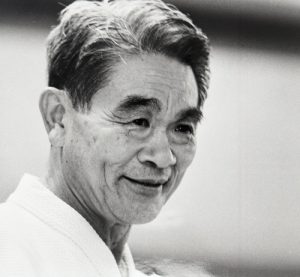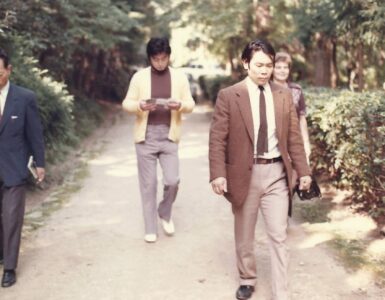The following is an excerpt from the newly released Aikido Pioneers: Postwar Era, which contains in person accounts and insights with many of the closest post-WWII students of the founder of aikido, including Shoji Nishio Sensei.
Shoji Nishio was born in 1927 in Aomori, in northern Japan. In 1942, at the age of fifteen, during the Second World War, he moved to Tokyo and began working for the Ministry of Finance in Japan’s mint. At the same time, he started practicing judo in a nearby dojo. He went on to study karate before finding aikido at age twenty-five. While training at the Aikikai Hombu dojo, he took up iaido and jodo. He taught at the Hombu dojo and other locations in Japan, and later taught aikido abroad as well. In addition to his eighth dan in aikido, Nishio Sensei earned numerous rankings and honors in other Japanese martial arts, including seventh dan in Nihon Zendoku iaido, sixth dan in Kodokan judo, and fifth dan in Shindo jinen-ryu karate, as well as training in Shindo Muso Ryu jodo (staff) and Hozoin Ryu yari (spear). His deep experience in these arts influenced his approach to aikido. He received the Budo Koryusho award from the Japanese Budo Federation for his lifetime contribution to the development and advancement of aikido throughout the world.
Aikido Journal: We understand that you first practiced judo and karate. What made you begin to train in Aikido?
At that time, a former karate sensei of the Butokukai named [Toyosaku] Sodeyama, who was running Konishi Sensei’s dojo and also teaching there, came up to me and said: “I met someone who is like a ‘phantom.’ I couldn’t strike him even once.” I was amazed that there was someone that even Sodeyama Sensei couldn’t strike. It was O-Sensei. Sodeyama Sensei came back to Japan after the war. Since he did not have anywhere to go, he came to Konishi Sensei. Then he was told to go to Hombu. Sodeyama Sensei laughed to himself, thinking that this aikido was being performed by such an old man. O-Sensei felt that the karate sensei was making light of him and said: “You are thinking that you can strike me, aren’t you?” Sodeyama answered: “Yes.” O-Sensei then responded: “I see. I see. Strike me. I’ll just walk around. If you can, strike me.” Then he started to walk around the dojo.

Sodeyama Sensei felt vexed, as though he was being made a fool of. If they had been confronting each other face to face, it would have been all right, but O-Sensei turned his back and started walking around, inviting him to strike. [Laughter] Sodeyama Sensei thought to himself: “What the hell kind of old man is this!” and suddenly got up and tried to strike O-Sensei. But O-Sensei turned around and said: “What’s the matter?” Sodeyama Sensei froze in the act of striking with his hand poised in mid-air. In the twinkling of an eye, there was a distance between them. Saying, “Damn it!” to himself, he tried to strike him again. Then O-Sensei repeated, “What’s the matter?” [Laughter] He couldn’t strike him at all. Then Sodeyama Sensei realized he had encountered a great sensei. He had to give full credit to O-Sensei, saying, “I give up!” It was Sodeyama Sensei who told Mr. Nakajima and me to go to see O-Sensei, and so we went. It was around 1951. Anyway, I went to see aikido and immediately joined the dojo.
They say that O-Sensei practiced the sword and staff, but he did so in the process of giving birth to modern aikido. Even though we imitate him, we will not be able to go beyond what he did. O-Sensei used to tell us, “This old man reached this stage, you should surpass me building on what I have left.” However, we tend to imitate what he did and end up going backward. Ten years from now, we may be practicing the level of aikido of O-Sensei as it was a number of years ago. After fifteen years, we may end up going back to the forms he practiced at an even earlier date. This is not right; he told us over and over again to go beyond what he did. People like us didn’t understand what he meant. But after several years, when we ran into some obstacle, we would think to ourselves, Oh, that’s what he used to talk about.” Our activities depend on O-Sensei’s words.
“Sodeyama Sensei laughed to himself, thinking that this aikido was being performed by such an old man. O-Sensei felt that the karate sensei was making light of him and said: “You are thinking that you can strike me, aren’t you?” Sodeyama answered: “Yes.” O-Sensei then responded: “I see. I see. Strike me. I’ll just walk around. If you can, strike me.” Then he started to walk around the dojo.”
I always say that if a teacher of aikido takes up the ken, he can reapply his knowledge to the ken. And the same is the case for the jo. [When I was a beginner] I asked how they applied the body techniques to the ken, but no one showed me. Since there was nothing to be done about the situation, I began practicing the ken in 1955, soon after I began aikido training. What else could I do? Nobody taught me! O-Sensei did sword techniques at lightning speed and would say, “That’s how you do it,” and then disappeared from the dojo…

After I began studying the ken, I started to appreciate how to handle it properly. When I combined it with the aikido way of thinking, I began to understand many things. So, I understood how what O-Sensei was saying made sense. This is our way of thinking. One step before the throw, victory and defeat are decided. You have the feeling of saying, “Do you understand? Now go!” and you release the attacker. The throw is as if you were saying, “Do you understand? Good luck!” and send him on his way. If you throw the attacker, trying not to injure him, he won’t hit his head. It is that very concern that is the most important aspect of humanity. It’s wrong to beat up the person you have just thrown after he has already given up. That kind of person is not a human being. People who know how to throw properly would hold the attacker’s head and throw him gently, so he doesn’t hit his head. Without that sort of mental composure, you shouldn’t throw.
“O-Sensei used to tell us, “This old man reached this stage, you should surpass me building on what I have left.” However, we tend to imitate what he did and end up going backward. Ten years from now, we may be practicing the level of aikido of O-Sensei as it was a number of years ago. After fifteen years, we may end up going back to the forms he practiced at an even earlier date.”
We were told that aikido came from the sword, but I was never convinced by the answers to my questions about this. So around 1955 I started to practice iai and also jodo. There were very few people doing iai at that time. Since I was doing it in order to learn aikido, I didn’t get caught up in a single style, but rather practiced a number of different systems. The schools were all different depending on the period from which they came. But this was something that was necessary. For example, something like the present institutionalized iai, which is based mainly on Omori-ryu, is not particularly useful for us. That system evolved into a part of the samurai etiquette during the Tokugawa period. It’s far from being a real fighting system. My doubts about it started with the way they wear the sword. It’s impossible to sit while wearing a long sword. That’s the position for the short sword. Samurai didn’t sit while wearing a long sword. If you went to someone’s house, you deposited your sword with the host. If you were somewhere where it was okay to have your sword, you placed it either behind you or on your opposite side. This was to show that you weren’t going to draw it.
The full dialogue with Nishio Sensei in included in Aikido Pioneers: Postwar Era, along with accounts from Seiseki Abe, Katsuaki Asai, T.K. Chiba, Seishiro Endo, Masatake Fujita, Shizuo Imaizumi, Kayoichi Inoue, Hiroshi Isoyama, Mitsunari Kanai, Yasuo Kobayashi, Morihiro Saito, Mitsugi Saotome, Masando Sasaki, Kenji Shimizu, Seichi Sugano, Hiroshi Tada, Hideo Takahashi, Mariye Takahashi, Nobuyoshi Tamura, Moriteru Ueshiba, and Yoshimitsu Yamada.













Thanks
Good stories to ponder on. They do help with one’s continuing development. Physical and mental and spiritual come with consistent practice and discipline. Must be patient but determined.